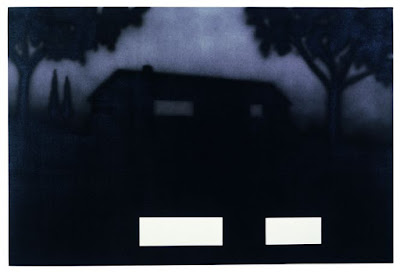Road webcam fascination - The silent pictures of Scandinavian traffic-webcams have a strange fascination for me. My previous outpourings of webcam obsession are here: 1: Discovery, 2: From deep space, 3: Don DeLillo, 4: Scipting surveillance art, 5: Making movies, 6: Sightings and glitches, 7: More sightings, 8: Google streetview, 9: Changes in time, 10: Events, 11: Living streetlight and 12: Dino Buzzati. I've used video, fiction, literary criticism, art, topography and surveillance technologies to think through this window on far-away places.
See update from 2024 down below >>>
I've watched this curve in the road many times. It's not the road that's fascinating. It's not the view over the fiord towards the mountains that's fascinating. It's the silhouette of the house above that road that I find captivating. This is Fv17 Torsvika, and the silhouette is not perfectly visible in this view.
It's much better if you zoom in and view just the house, like I do below. Then you can see a "dark painting" depicting a silhouette. A dark façade face with luminous windows for eyes.
Then you'll notice that the house looks quite ordinary in sunny weather, when it's illuminated from the front and you see all the details. It's also not that impressive if you search it on Google maps, there you see that it's a nice, interesting but non-mysterious building. But when you look in the proper light, the house turns into an Ed Ruscha artwork.
In his book Leave any information at the signal : writings, interviews, bits, pages by Ed Ruscha (and Alexandra Schwartz) the artist says in one interview:
TB: Let’s talk about the dark paintings.
ER: I think they came mostly from photography, although they are not photographically done or anything. I feel that they are related to the subject of photography. I think these works somehow share something with photography. I don’t know why. I have a definite side to side horizontal brushstroke. It’s part of the concept of the landscape, I guess, and I painted all my pictures like that. These newer paintings are dark and strokeless. They’re painted with an air brush.
TB: What is the effect of absenting figures from your paintings? Particularly your gas station paintings, which are almost desolate.
ER: I think they become more powerful without extraneous elements like
people, cars, anything beyond the story. That’s why these lines, these planes in a gas station were more important than trying to create an Edward Hopper scene. It became something for me to investigate. I was able to subtract a romantic story from the scene - I wanted something that had some industrial strength to it. People would muddle it. There was a coldness that I liked when I painted those pictures.
BB: How do you make up the images, or do you make them up? How do you go from the elephant to the ship to the rows of houses?
ER: It’s the icon/logo concept, I suppose. Things that are immediately recognizable. The idea is that recognition and a silhouette go hand in hand. I get the imagery from all sources. I may have seen several ships and then I’ll work on a drawing, change it, put some masts over here, a sail here. I never consider the drawings anything but preparatory - they’re not things in themselves, that’s why I don’t show rough sketches. Finally, I just enhance the thing back to a silhouette position, a silhouette appearance. Then that goes on the canvas in the form of an outline, and that’s where I start working. The images just come from anywhere - a magazine, a photograph of an old ship.
For the last two or three years, Ruscha’s fantasies have also included “grand horizontal” paintings that nudge words and phrases into a kind of cosmic dialectic. The thirteen-foot-long rectangular backgrounds of these paintings represent Panavision-like sunsets or, more recently, the ionosphere at night, and serve as stage sets for expeditions from one extreme set of concepts to another. Tiny white letters on the left end of one canvas, for example, say “wolves/explosions/disease/poisons,” while on the other side of the curving globe, to the right, we find “home.” On another canvas “ancient dogs barking” is lettered on the far left corner, and “modern dogs barking” on the far right.
Update 2024
This is how it looks now. Still the same:










No comments:
Post a Comment